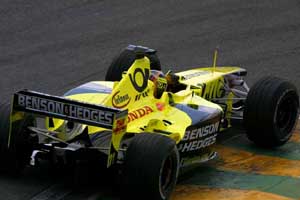Features - Year in Review
DECEMBER 1, 2001
Jordan-Honda

Head-to-head with BAR as the second official Honda factory team, Jordan started the year in upbeat mood with the new EJ-11 which highly impressed regular drivers Heinz-Harald Frentzen and Jarno Trulli at first acquaintance. Former BAR teamster Ricardo Zonta signed as test driver.
However, Frentzen's early season satisfaction with the EJ-11 gradually dissolved as Trulli proved the more effective performer in qualifying. This prompted Frentzen, who finds it difficult tackling mid-corner understeer, to go off at a tangent in a bid to convince Jordan that it should be seeking to develop alternative chassis set-ups with which he could cope.
This was part of the process which led to Frentzen's performances going off the boil and Eddie Jordan dropping him from the team after the British Grand Prix. Two accidents, at Monaco and in practice at Montreal, had also undermined Frentzen's confidence and test driver Ricardo Zonta stood in for the Canadian and German GPs.
The bottom line was that Jordan once again failed to make the crucial and long overdue graduation to F1's first division. Only two years had passed since Frentzen won two Grands Prix in 1999 and the team seemed poised on the edge of a breakthrough. It didn't happen. 2001 was every bit as disappointing as the 2000 season had been, even though they had started the year buoyed up by the switch from Mugen-Honda power to a full factory engine deal.
There were some downside problems, including the fact that Technical Director Mike Gascoyne had left to join Benetton and his replacement Eghbal Hamidy could not take up his new post until the start of the season. Yet it was not the effects of these management changed which took the edge of the Jordan-Honda performance, it was the dismal record of technical failures and malfunctions.
The team came into the season off the back of a multitude of overheating problems during the winter and these were followed by a raft of technical difficulties bred out of component supply problems. There was much work to be done in house on developing traction control - there was no Pi Research or TAG Electronics deal to short-cut solutions to problems on this front. It also went without saying that Honda simply did not develop their engine program as aggressively or efficiently as is required by top-line F1 standards. Rivals BAR also suffered badly on this front.
Then Jean Alesi joined up for the Hungarian race, but none of this experimentation could alter the fact that Jordan's cars were also depressingly unreliable and Honda - as BAR discovered - also did an average job at best. Battling to compensate for the lack of power left Jordan trading downforce for grip at too many tracks in an effort to squeeze more straight line speed out of their car. This is always an uncomfortable compromise.
As for the future, it is extremely difficult to judge what Jordan might achieve in 2002. Pairing Takuma Sato and Giancarlo Fisichella probably gives them the strongest line-up since Damon Hill and Ralf Schumacher in 1998. Now all they have to do is make the best of it.